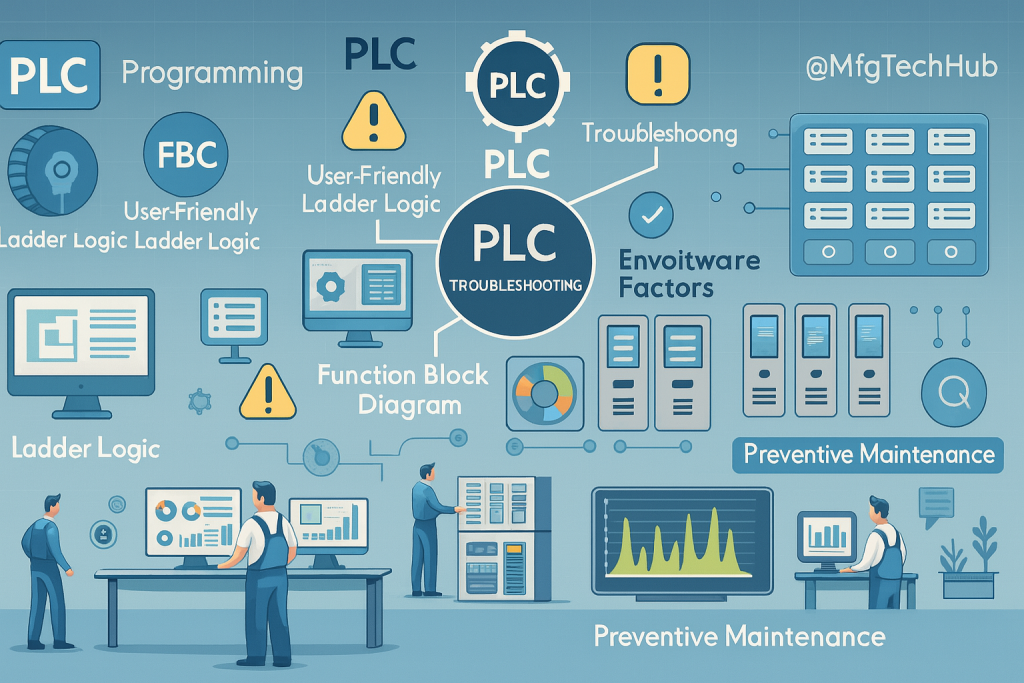Challenges and Considerations – Troubleshooting and Maintenance
While Programmable Logic Controllers (PLCs) are highly reliable, they are not immune to faults, errors, or failures. Troubleshooting and maintenance play a critical role in ensuring continuous operation, minimizing downtime, and preventing costly disruptions in industrial processes.

This page explores common PLC issues, troubleshooting techniques, preventive maintenance strategies, and best practices to keep automation systems running smoothly.
1. Common PLC Issues and Faults
A. Hardware Failures
PLC hardware consists of power supplies, processors, input/output (I/O) modules, and communication interfaces. Failure in any of these components can disrupt automation processes.
- Power Supply Failure – Causes unexpected system shutdowns.
- I/O Module Malfunctions – Leads to incorrect sensor readings or failed actuator responses.
- Processor Overheating – Results in system crashes or slowed performance.
- Corroded or Loose Wiring – Causes intermittent connection issues.
Example: In a steel manufacturing plant, an I/O module failure led to incorrect conveyor belt speed adjustments, disrupting production flow.
B. Software and Programming Issues
Faulty programming or software bugs can lead to erratic PLC behavior.
- Logic Errors – Incorrect ladder logic or structured text commands result in unexpected outputs.
- Memory Overload – Excessive data storage slows down processing speed.
- Watchdog Timer Errors – If the PLC program takes too long to execute, the system automatically resets.
- Communication Failures – Misconfigured network settings lead to lost data between devices.
Example: A pharmaceutical company experienced batch inconsistencies due to unoptimized PLC logic controlling ingredient dispensing.
C. Environmental and External Factors
PLCs are often installed in harsh industrial environments where temperature fluctuations, humidity, dust, and vibrations can cause failures.
- Overheating – High temperatures cause component degradation.
- Electrical Noise (EMI/RFI) – Nearby motors or power lines interfere with signal transmission.
- Vibration & Shock – Loose connections and failing circuit boards lead to random shutdowns.
- Humidity & Corrosion – Moisture causes short circuits and rusting of electrical contacts.
Example: In a water treatment facility, a PLC failure occurred due to condensation buildup, leading to unexpected system shutdowns.
2. Troubleshooting PLC Systems – Step-by-Step Guide
Effective troubleshooting ensures minimal downtime and helps identify root causes quickly.
Step 1: Verify Power Supply
- Check voltage levels to ensure the PLC is receiving adequate power.
- Inspect power cables and connectors for damage.
Example: A bottling plant experienced random shutdowns, which were later traced to a loose power cable on the PLC power supply unit.
Step 2: Check Error Codes and Alarms
- Most modern PLCs have diagnostic LEDs or error logs.
- Read fault codes using programming software.
Example: An automobile assembly line encountered motor failures. The PLC’s diagnostic log revealed an overcurrent issue, helping engineers fix it quickly.
Step 3: Inspect I/O Modules and Sensors
- Use test meters or simulation tools to verify input/output readings.
- Check wiring, terminal connections, and fuses.
Example: A conveyor belt stopped unexpectedly because a photoelectric sensor wire was cut.
Step 4: Check Communication Networks
- Ensure PLC network cables are intact and configured correctly.
- Verify IP addresses, baud rates, and protocols (Modbus, Profibus, Ethernet/IP, etc.).
Example: A remote monitoring system failed to receive PLC data due to a misconfigured Ethernet port.
Step 5: Review PLC Program and Scan Time
- Monitor PLC scan cycle times to detect inefficiencies.
- Use debugging tools to step through logic execution.
Example: A sorting machine misrouted packages due to a delayed logic execution, which was fixed by optimizing scan time.
3. Preventive Maintenance for PLC Systems
To avoid failures, industries implement proactive maintenance strategies.
A. Routine Inspections
- Visual Checks – Look for loose wires, overheated components, and dust buildup.
- Power Supply Monitoring – Regularly inspect voltage fluctuations and grounding.
- Check Battery Backup – Many PLCs use batteries for memory retention. Replace them periodically.
Example: A food packaging facility prevented unplanned downtime by replacing aging power supply units before failure.
B. Software Maintenance and Updates
- Regular Program Backups – Prevents data loss during failures.
- Firmware Updates – Ensures latest security patches and bug fixes.
- Document Changes – Keep track of software modifications.
Example: A brewery lost critical PLC data after a power failure. Luckily, they restored the backup program, minimizing production loss.
C. Environmental Protection Measures
- Use PLC Enclosures – Protects against dust, moisture, and temperature extremes.
- Reduce Electrical Noise – Shield PLCs from high-power devices to prevent EMI interference.
- Improve Ventilation – Keeps components cool and prevents overheating.
Example: A cement plant installed heat-resistant PLC enclosures, improving system longevity in high-temperature conditions.
4. Best Practices for PLC Troubleshooting & Maintenance
- Train Operators – Ensure workers can diagnose minor PLC issues before calling engineers.
- Standardize Spare Parts – Keep backup PLC modules, relays, and I/O boards available.
- Use PLC Simulators – Test and debug new logic in a virtual environment before deployment.
- Implement Remote Monitoring – Allows early fault detection and predictive maintenance.
Example: A power generation plant reduced downtime by 40% by implementing remote PLC diagnostics.
5. Future Trends in PLC Maintenance
- AI & Machine Learning for Predictive Maintenance – AI-based PLC monitoring will predict failures before they happen.
- Cloud-Based PLC Analytics – Remote monitoring of PLC performance from any location.
- Self-Healing Systems – PLCs will automatically adjust control logic to compensate for minor issues.
- IoT-Enabled Smart PLCs – Real-time diagnostics via connected IoT sensors.
Example: A smart oil refinery uses AI-powered PLCs to detect pump anomalies before breakdowns occur, improving efficiency.
Effective troubleshooting and maintenance are essential for maximizing PLC reliability, reducing downtime, and preventing costly system failures.
Key Takeaways:
- Common PLC issues include hardware failures, programming errors, and environmental factors.
- Systematic troubleshooting ensures fast issue resolution.
- Preventive maintenance extends PLC lifespan and minimizes risks.
- Future trends include AI-driven predictive maintenance and cloud-based PLC analytics.
